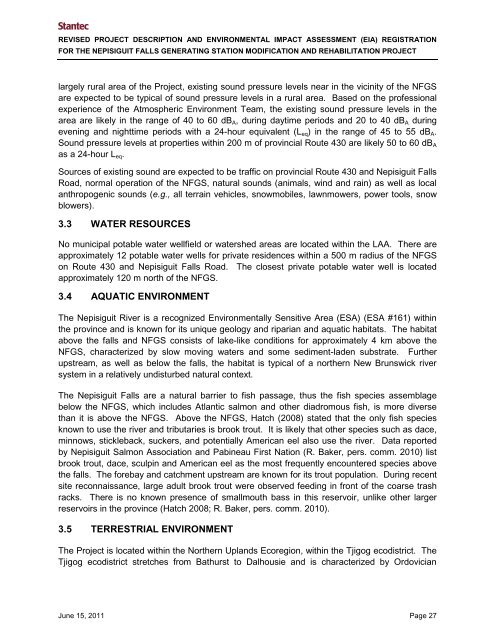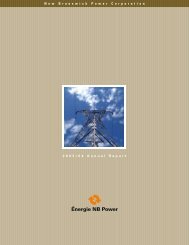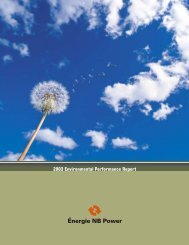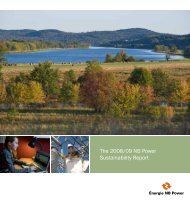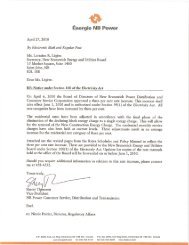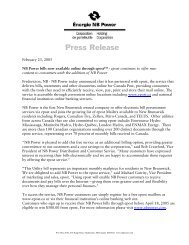Environmental Impact Assessment(EIA) Registration for the ...
Environmental Impact Assessment(EIA) Registration for the ...
Environmental Impact Assessment(EIA) Registration for the ...
You also want an ePaper? Increase the reach of your titles
YUMPU automatically turns print PDFs into web optimized ePapers that Google loves.
REVISED PROJECT DESCRIPTION AND ENVIRONMENTAL IMPACT ASSESSMENT (<strong>EIA</strong>) REGISTRATION<br />
FOR THE NEPISIGUIT FALLS GENERATING STATION MODIFICATION AND REHABILITATION PROJECT<br />
largely rural area of <strong>the</strong> Project, existing sound pressure levels near in <strong>the</strong> vicinity of <strong>the</strong> NFGS<br />
are expected to be typical of sound pressure levels in a rural area. Based on <strong>the</strong> professional<br />
experience of <strong>the</strong> Atmospheric Environment Team, <strong>the</strong> existing sound pressure levels in <strong>the</strong><br />
area are likely in <strong>the</strong> range of 40 to 60 dB A , during daytime periods and 20 to 40 dB A during<br />
evening and nighttime periods with a 24-hour equivalent (L eq ) in <strong>the</strong> range of 45 to 55 dB A .<br />
Sound pressure levels at properties within 200 m of provincial Route 430 are likely 50 to 60 dB A<br />
as a 24-hour L eq .<br />
Sources of existing sound are expected to be traffic on provincial Route 430 and Nepisiguit Falls<br />
Road, normal operation of <strong>the</strong> NFGS, natural sounds (animals, wind and rain) as well as local<br />
anthropogenic sounds (e.g., all terrain vehicles, snowmobiles, lawnmowers, power tools, snow<br />
blowers).<br />
3.3 WATER RESOURCES<br />
No municipal potable water wellfield or watershed areas are located within <strong>the</strong> LAA. There are<br />
approximately 12 potable water wells <strong>for</strong> private residences within a 500 m radius of <strong>the</strong> NFGS<br />
on Route 430 and Nepisiguit Falls Road. The closest private potable water well is located<br />
approximately 120 m north of <strong>the</strong> NFGS.<br />
3.4 AQUATIC ENVIRONMENT<br />
The Nepisiguit River is a recognized <strong>Environmental</strong>ly Sensitive Area (ESA) (ESA #161) within<br />
<strong>the</strong> province and is known <strong>for</strong> its unique geology and riparian and aquatic habitats. The habitat<br />
above <strong>the</strong> falls and NFGS consists of lake-like conditions <strong>for</strong> approximately 4 km above <strong>the</strong><br />
NFGS, characterized by slow moving waters and some sediment-laden substrate. Fur<strong>the</strong>r<br />
upstream, as well as below <strong>the</strong> falls, <strong>the</strong> habitat is typical of a nor<strong>the</strong>rn New Brunswick river<br />
system in a relatively undisturbed natural context.<br />
The Nepisiguit Falls are a natural barrier to fish passage, thus <strong>the</strong> fish species assemblage<br />
below <strong>the</strong> NFGS, which includes Atlantic salmon and o<strong>the</strong>r diadromous fish, is more diverse<br />
than it is above <strong>the</strong> NFGS. Above <strong>the</strong> NFGS, Hatch (2008) stated that <strong>the</strong> only fish species<br />
known to use <strong>the</strong> river and tributaries is brook trout. It is likely that o<strong>the</strong>r species such as dace,<br />
minnows, stickleback, suckers, and potentially American eel also use <strong>the</strong> river. Data reported<br />
by Nepisiguit Salmon Association and Pabineau First Nation (R. Baker, pers. comm. 2010) list<br />
brook trout, dace, sculpin and American eel as <strong>the</strong> most frequently encountered species above<br />
<strong>the</strong> falls. The <strong>for</strong>ebay and catchment upstream are known <strong>for</strong> its trout population. During recent<br />
site reconnaissance, large adult brook trout were observed feeding in front of <strong>the</strong> coarse trash<br />
racks. There is no known presence of smallmouth bass in this reservoir, unlike o<strong>the</strong>r larger<br />
reservoirs in <strong>the</strong> province (Hatch 2008; R. Baker, pers. comm. 2010).<br />
3.5 TERRESTRIAL ENVIRONMENT<br />
The Project is located within <strong>the</strong> Nor<strong>the</strong>rn Uplands Ecoregion, within <strong>the</strong> Tjigog ecodistrict. The<br />
Tjigog ecodistrict stretches from Bathurst to Dalhousie and is characterized by Ordovician<br />
June 15, 2011 Page 27


